Growing diversity in the Finger Lakes
by Derrick Gentry –
I am an amateur gardener, as all gardeners are, and more recently I have become a middle-aged 4-H student. Whenever this student is invited, he always leaps at the chance to go outside and join other amateurs on pasture walks and garden tours and homestead visits. So this past August, when my family heard news of the 5th annual Permaculture Weekend — held in various locations outside of Ithaca, and featuring workshops and open house tours and lots of good food — my wife and seven-year-old son (an actual 4-H-er) eagerly packed our bags for a weekend trip to see what our neighbors down south were up to.
What is permaculture? And who are the kinds of people who do it and who attend things like Permaculture Weekends? I am something of a fellow-traveling permie sympathizer, and I do spend a lot of my time in permie youtube dives, so I feel I can make a decent attempt at a rough definition for the general reader. In what follows, however, I will focus mostly on the second question – the one about people. Because at bottom, permaculture is about people doing things on a human scale and choosing to live their lives in a certain way.
***
First, the general definition…
The term “permaculture” dates back only to the late 1970s (the Australians Dave Holmgren and Bill Mollison get the credit for coining it). Like most ideas, permaculture can be paraphrased and packaged into something like a formula. Permaculture has its own set of cliched jargon terms: guilds, polycultures, berms and swales, nitrogen fixers and dynamic bioaccumulators, and so on. All of these terms will generate many search results on youtube. If we want, we can also formulate a series of dogmatic-sounding axioms and injunctions associated with permaculture: no till, cultivate hardy perennials rather than annuals, don’t let the sun catch your soil bare, and comfrey, comfrey, and more comfrey. (Full disclosure: I look out my window, and I see comfrey, comfrey, comfrey…)
From another point of view, permaculture is simply a new name for some old ways of thinking and some practices that have been proven to work over the long term. The central principle of permaculture is the least dogmatic and truest of clichés: It all depends. What we do – as farmers, as gardeners, as stewards of the land – all depends on our local sense of place. Every site is a little ecosystem with its own rules and parameters, and it takes time to observe closely and find out what those are. Observe closely and get to know your plot of land: That is the widely accepted first principle of permaculture. Like all relationships, the two-way give-and-take between land and steward requires time to grow and develop.
Another permaculture principle is simply the uplifting reminder that alternative ways of thinking about things result in alternative ways of doing things. A whole world of possibilities opens up when we become close observers of our surroundings, choose to work with rather than against nature, and when we stop talking about “nature” (as in “working with it…”) in the aloof third-person voice. Permaculture is a highly flexible discipline, but it does remind us that we might need to change some of our familiar ways of doing things. And that is always hard.
Now on to the people my family and I met as invited guests on Permaculture Weekend…
Shelterbelt Farms
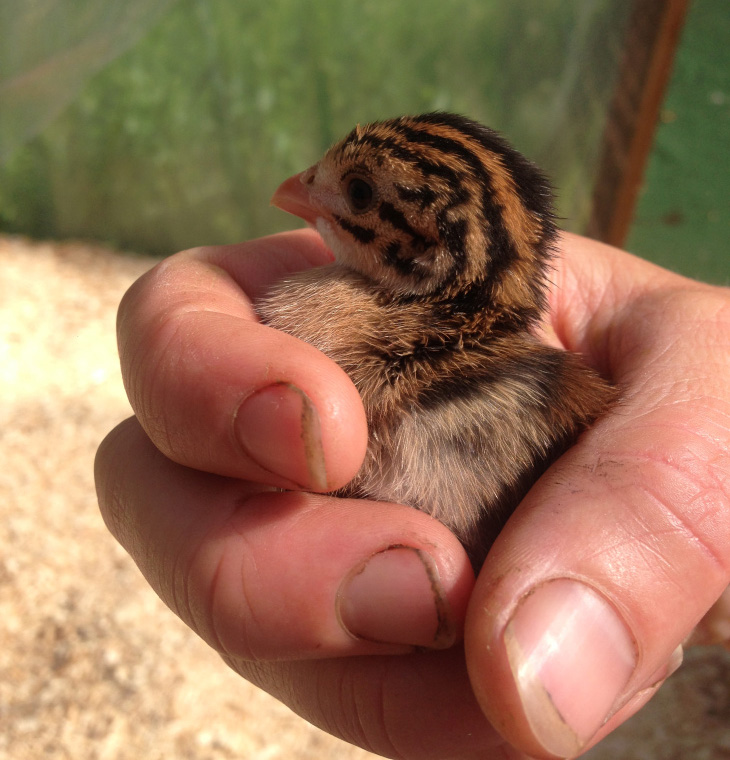
Our first stop was Shelterbelt Farms, a 25-acre farmstead in Brooktondale, NY run by Erica Frenay (with help from her husband and two children). When Erica and her family purchased the acreage in 2005, it had been an abandoned farm for more than 30 years. Most of the topsoil had washed away due to season after season of reckless and repeated tillage, the pH of the soil was under 5, and most of the land was carpeted with moss and thatched over with shrubby overgrowth. It was not until 2010 – after five years of getting to know their land and bringing it back to life – that Shelterbelt Farm began growing food and planting orchards to establish what is now a thriving market garden endeavor.
Today, they sell a wide a range of goods to a local community of customers. In her time away from the farm – though it is hard to imagine her having the time – Erica works for the Small Farms Program at Cornell. Her natural talents as an educator and her deep desire to share ideas were on display as she led our group on a tour of Shelterbelt on a bright and beautiful Saturday morning.
Erica gave us a list of permaculture “design principles” that has helped guide her in her various decisions as steward of the land. One of them she adapted from Dave Holmgren: To encourage diversity at all levels: human, wildlife, plantings, pasture composition, and income streams. As I looked over the other principles on her list – Use and Value Renewable Energy and Resources, Produce No Waste, Small and Slow Solutions, and so on – I noticed that every one of them is deeply rooted in ecological thinking. When she speaks of her restorative grazing project, Erica often employs the language of ecology. “Pigs succeed chickens,” she explained, and the fertility and biodiversity of the land came to life in the wake of this carefully timed successional grazing. “The poultry,” she noted at one point, “are here for their ecological services. The eggs are just a byproduct.”
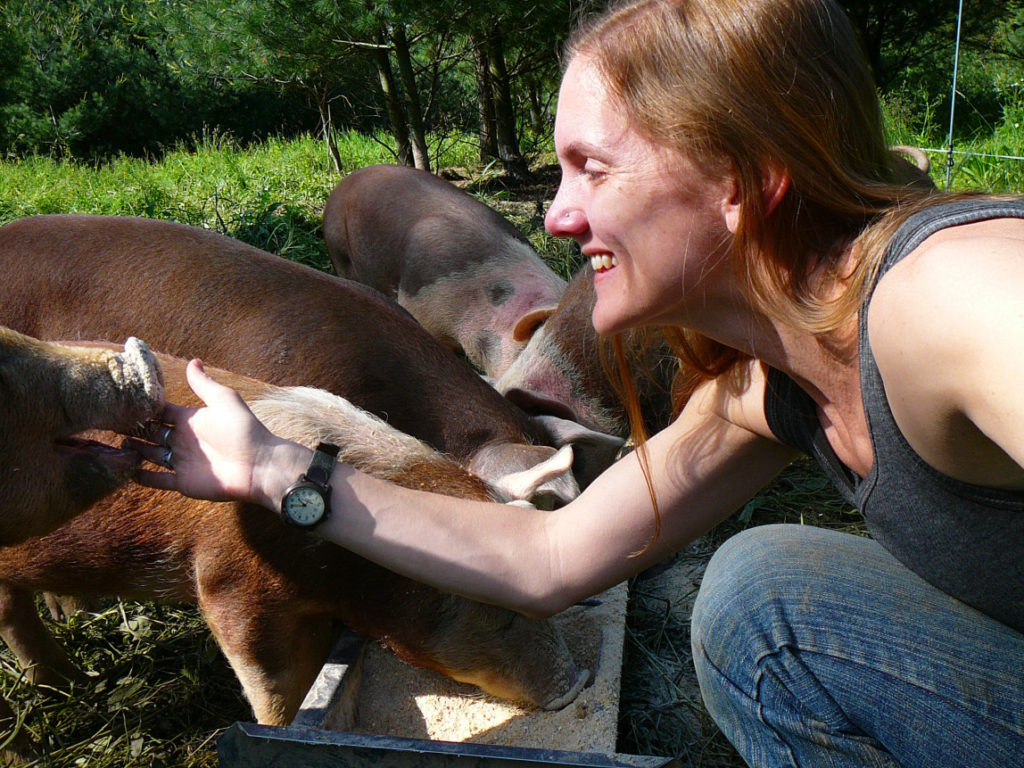
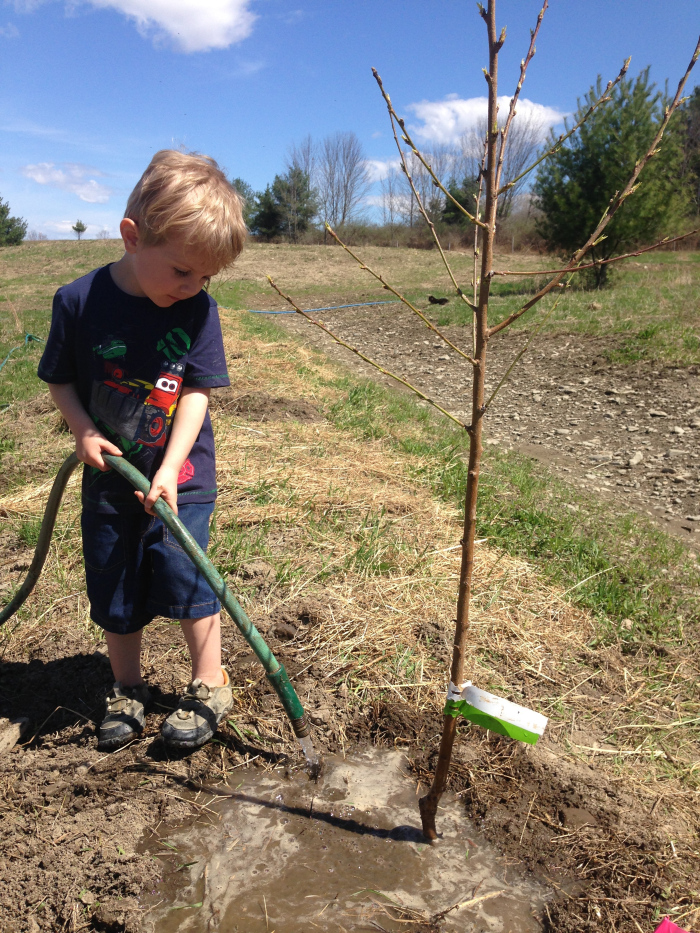 Shelterbelt Farm is a vivid example of the natural marriage between permaculture and what is known as holistic grazing. Grazing and foraging animals have long played a role in the health of ecosystems, and for many permaculturists animal husbandry and holistic grazing practices are an integral part of their attempt to mimic time-tested ecological processes. (There is also the practice of vegan permaculture, which has developed a different and equally fascinating set of practices for building fertility without animals).
Shelterbelt Farm is a vivid example of the natural marriage between permaculture and what is known as holistic grazing. Grazing and foraging animals have long played a role in the health of ecosystems, and for many permaculturists animal husbandry and holistic grazing practices are an integral part of their attempt to mimic time-tested ecological processes. (There is also the practice of vegan permaculture, which has developed a different and equally fascinating set of practices for building fertility without animals).
Erica’s “flerd” (rotating flocks and herds) have certainly played an integral role in dramatic transformation of their pasture and (more recently) in their orchard. The flush of fertility is hard to miss. Much of the formerly moss-covered land we toured is now a pasture vibrant with life and rich with diversity. Using only carefully timed rotations of grazing animals, Erica was able to build top soil and establish forage: birds foot trefoil, clovers, grasses. Her pasture employs the most cutting-edge solar energy and carbon capture technology available: legumes fixing nitrogen and building the soil, grasses converting the rays of the sun into food for grazing animals, who convert that energy into protein that humans can eat. It is a highly efficient system.
Erica’s daughter Rowan is a talented floral arranger with her own eye for small-scale design. As we left Shelterbelt, we stopped at her table and bought a lovely arrangement of various plants that all fit within a tiny porcelain cup. Weeks later, the cup now sits on our window sill, and they still look lovely.
Edible Acres Nursery
The next two stops on the tour were both small-scale nurseries.
Edible Acres, located in Trumansburg, describes itself as a “permaculture nursery and forest farm” focusing on “edible perennials and resilient designs that are easy to learn.” The business is run by Sean Dembrosky and his partner Sasha. Sean is something of a youtube permie-celebrity with many followers (myself included), and he posts DIY videos on various things that are “easy to learn.”
Sean loves “forest garden” perennials – trees and bushes producing nuts and fruits – but he also extols the virtues of the ephemeral annuals that fill an important niche. I saw no sign of Sean harboring a bias or dogma with regard to annuals. He does abhor a bare-soil vacuum, however. If there is an unoccupied patch of soil, he says, then you can always toss in some seeds as a temporary cover crop (even if it covers only a few square feet). Sometimes they fill a very tiny niche indeed. He pointed to a bare patch in his garden that most people would not even consider “bare,” and he noted that there was still time in the season – late as it was – to squeeze in some buckwheat or field peas. Why not?
Why not. His casual, laissez faire attitude towards planting and propagation in general makes possible the kinds of happy accidents that account for much of the pleasure of gardening. He spoke to us of a tree that had matured buried in the back of his property, a tree he forgot that he had planted. And the darnedest things reseed and come back the next season. I imagine
Sean forgetting about that patch of buckwheat he planted, letting it go to seed and seeing that as just another happy accident.
Sean grows things in pretty tight quarters, mostly ignoring the standard recommended spacing. That is part of his approach. His attitude is essentially: Try lots of things at once, put everything close together, and see what happens within the ecosystem that takes shape. From this point of view, everything is an experiment. Sean’s aim is to encourage polycultures, not plant just one thing in isolation. He describes his method in one phrase: “hedge your bets.” It is a long-term vision of ecological process that his stewardship seeks to mimic.
On one of our tour stops, Sean drew our attention to the freeze-frame of a polyculture that was establishing at the base of a peach tree. The scope of his long-term design vision became apparent. “When this tree has matured and died,” he explained, “these understory guild species will then have begun to thrive and mature.” He was talking about many years down the road. When we design polycultures, he said, “we need to think 200 years ahead.” This is the same ecological succession talk that we had heard from Erica. But now we were out of the pasture and talking instead about canopies and understories and the interlocking lifespans of annuals and perennials and biennials.
Toward the end of our visit, as Sean explained the sharing arrangement he had with the local deer, someone in our party asked him whether he had personally contracted Lyme’s Disease. He had indeed, and so had Sasha (who was back at the house). Sasha had just recovered from a particularly debilitating bout earlier in the year. Lyme’s disease was something they both had to live with. But Sean’s ultimate advice to us was: “Just get it, and get it over with.” We all laughed. On reflection, though, what he said harmonized with the rest of his long-term attitude. “Get it over with” — in essence, do not let the fear of what might happen define and govern your life.
There was hardly a moment on our tour of Edible Acres when we were not eating something picked along the way. Don’t forget to toss your pits on the ground, Sean reminded us, as squirrels darted around busily in the background.
Twisted Tree Farm
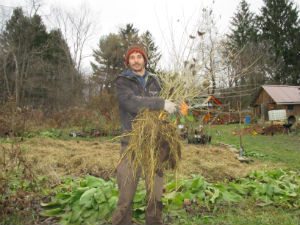
Nurseries – like Edible Acres and the one we visited next – follow a peculiar business model. They are highly exploitative or highly collaborative, depending on how you look at it. Whenever I order seeds or plants from Edible Acres, part of me feels like one of Sean’s hired squirrels.
There were squirrels, busy as elves, running all around Twisted Tree Nursery in the town of Spencer. Twisted Tree is a 20-acre homestead/nursery run by Akiva Silver and “dedicated to growing healthy trees, food, and family.” They do not use synthetic fertilizers, pesticides, or herbicides – and, as Akiva notes, that is “surprisingly rare” in the nursery business. Their trees, and their business, are rooted in “living soil using compost, wood chips, and low-tech common sense.”
Their methods obviously work. The Twisted Tree site looks like the messy office of someone who is brimming with ideas and trying out various things at once – a man who is happily hedging his bets and probably trying to do too many things at once. (I’m not sure if I am projecting or rationalizing my own disorder…)
Akiva’s business is an insidious plot to get people to become more squirrel-like. Akiva believes that if we all dedicated ourselves to the busy-ness of promoting biodiversity at home, then we might stand a chance of restoring what has been lost to clear cutting and the dominance of tassel-waving monocultures.
Akiva is a man of slight build, and on this afternoon he was wearing shorts and a threadbare t-shirt. His voice is about as modest as his dress, but his enthusiasm also
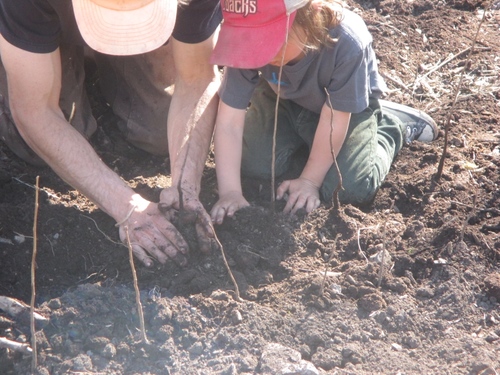
makes him the kind of speaker who has no trouble holding an audience’s attention. At one stage of our tour, Akiva spoke at length about the virtues of the black locust tree. But he made a particularly eloquent case for the iconic American Chestnut as in some ways the ultimate permaculture crop.
He also re-told the sad story of its loss. In 1900, as the saying goes, a squirrel could travel from Maine to Georgia on the tree tops of the majestic chestnut. A diverse range of forest wildlife could feed itself on the bounty of the chestnuts that covered the ground, in addition to the acorns and hickory nuts and other choices available at different times of the season. That forest ecosystem collapsed suddenly in the early years of the twentieth century, when the chestnut blight was brought to America by busy traveling humans. It may very well be the single worst ecological disaster this continent has ever experienced.
The project of searching for a blight-resistant variety of chestnut continues to this day – in the labs of research institutions, but also on the property of average people who plant chestnuts and promote and experiment with biodiversity in their own backyards. These are Akiva’s “customers.” Twisted Tree is a front for an ecological restoration project, and Akiva is doing very much the same thing that Erica and Sean are doing.
As he spoke to us with his deep knowledge and enthusiasm, Akiva was also making an implicit case, I think, for the role of the amateur “citizen scientist.” Akiva is conducting an experiment in his backyard that, in its way, is just as important and cutting edge as anything Cornell is doing. I thought, for example, of Darwin’s affection and admiration for amateur pigeon breeders. It also occurred to me that Darwin would have loved the internet, and he would likely be a subscriber to Akiva’s youtube channel.
As the tour ended, we were reminded about the the sixth annual Nut Bonanza to be held at Twisted Tree on November 10th. All are invited, though we are warned ahead of time that the squirrels will more than likely arrive first. The event will culminate in a biochar-making bonfire. (You can find out what biochar is on youtube…)
Thoughts on the way home
The final event of the Permacuture Weekend was at Cayuta Sun Farm, a business located in the town of Catharine and offering “Pastured Meats and Woodland Products.” There we were treated to a wonderfully tasty lunch of pasture-raised pork sausages and summer garden veggies in their prime. We ate within sight of the garden, almost within it.
I remember after lunch I had a chance encounter with a woman from India who was in her mid 80s, a former opera singer who was dressed in elegant traditional Indian clothing. We sat in the shade of tree – the second day of the weekend was much hotter than the first. We talked about food and music, while her grandchildren and my son played under the shade of another tree. You never know who you are going to have the pleasure of eating with at these permaculture gatherings…
As we headed back north to return home, I tried to think of what all of these various permaculture endeavors had in common – some motto or image (or headline?) that might capture the attitude and spirit that tied together everything that Erica, Sean, Sasha, and Akiva were doing. One general observation I could easily make is that they were all in their different ways aiming to encourage and restore diversity at all levels, with an eye for what we now routinely call long-term sustainability.
I can also say that the people I met and just about all the permies I know are life-loving, cheerful, generous people. The business motto for Shelterbelt Farm is: “Food for your soul, with love from our soil.” But make no mistake: Permaculture casts itself as an alternative to an unsustainable path that, alas, is not at all unthinkable. We may not like to think about it, but the definition of “unsustainable” means, among others, “tending toward collapse.” A culture heading in that direction is in just about every respect the opposite of a permaculture.
Will permaculture save the world? The answer is probably not, and no permaculturist I know would make that claim or even frame the question that way. Permaculture is more at home on DIY youtube channels than it is on the brightly lit stage of a TED talk. Permaculture does, however, affirm its faith in the resilience of complex systems. The system works, and we are part of it. And then the conversation quickly turns to ideas-sharing and DIY talk.
As we drove home, Sean’s advice to “hedge your bets” and his suggestion that we embrace Lyme’s disease and “get it over with” also brought to my mind another slogan I have heard that represents another possible plan for the future: Collapse now and avoid the rush. I understand that sentiment, and I know my permaculture friends do too. I have a taste for dark humor; but “the rush” is a euphemism for a possible future that terrifies me. As the father of a seven-year-old, and as someone who loves life and wants others to love it as well, I find these survivalist go-it-on-your-own attitudes unhelpful at the end of the day.
And that highlights another general feature of permaculture that is significant to me. Yes, I have heard permaculturists use the word “collapse” and “over-reach.” And they certainly have a keen sense of what “unsustainable” means. But far more often in these circles, I hear words like “transition” and “resilience” and the word “future” as something to build, rather than something to prepare for or to contemplate in fear. Within permaculture circles, I also hear a lot of talk about widening the circle. A more locally-sourced sentiment comes to my mind that fits both permaculture and the personalities we encountered: “Sing Songs and Sow Seeds,” the motto of Fruition Seeds in Naples.
When I am not poking about in my garden or watching my goats nibble off the tops of common red clover, I spend my work days sitting in college classrooms with mostly young students. At this point, the future is more theirs than it is mine. We sit together and hone our critical thinking skills by describing systemic problems like soil erosion and the erosion of civility in public life. We have a lot of things to make sense of these days. But in the end, we all realize that the point is not to describe the world, nor even to change it. The point is to live in the world, as happily and harmoniously as we can manage – for the long-term, hedging our bets, singing songs as we sow seeds. Rachel Carson, that proto-permaculturist and exemplar of critical thought, captured the common sense perfectly: “Those who contemplate the beauty of the earth find reserves of strength that will endure as long as life lasts.”
D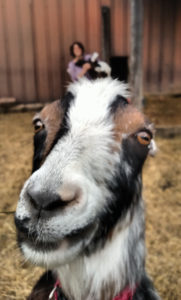 errick Gentry lives in Canadice with his wife and son, and numerous furred and feathered friends.
errick Gentry lives in Canadice with his wife and son, and numerous furred and feathered friends.
He teaches in the Humanities Department at Finger Lakes Community College.
Derrick.Gentry@flcc.edu